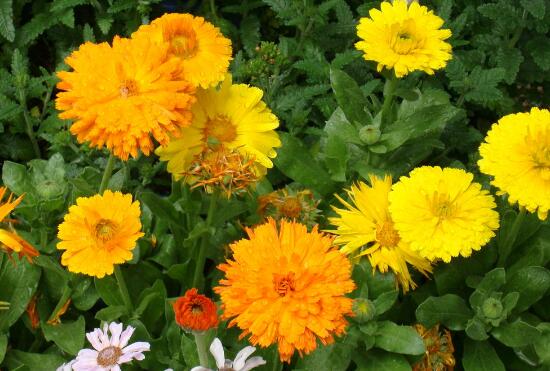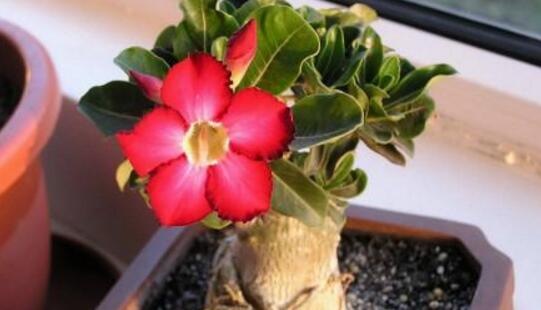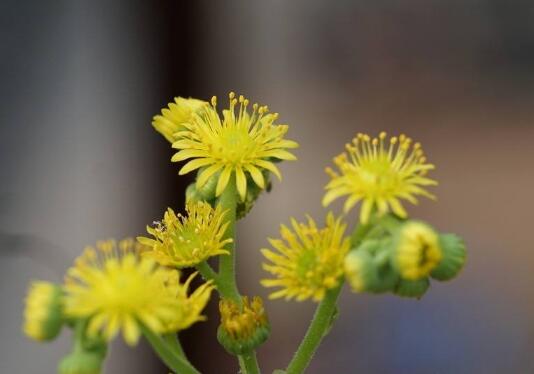How to do marigold leaves yellow, pay attention to 7 points yellow worry-free/appropriate fertilization for large pots
Calendula, a kind of ornamental flowers, is deeply loved by flower friends for its beautiful flowers and bright colors. In life, there are many people who raise calendula, but when beginners raise it, they often encounter the situation that the leaves turn yellow, which seriously affects the ornamental. What about the marigold leaves that turn yellow? In this regard, the editor summarized the seven reasons for the yellowing of marigold leaves, let's go and have a look!
First, how do the marigold leaves turn yellow? find the cause.

Although marigolds are easy to raise, once they are not properly maintained, for example, if we do not strictly follow the breeding methods of marigolds, the leaves may turn yellow. People often think that the calendula is sick, in fact, this is only one of the reasons, watering, fertilization, improper lighting will cause yellow leaves. Here are 7 causes and solutions for the yellowing of marigold leaves. Let's move on.
Second, the causes and solutions of the yellowing of marigold leaves.
1. Environmental mutation
In fact, there are many reasons for the yellowing of marigold leaves, but environmental factors are the first thing to consider. The reason for this is that many flower friends buy marigolds online, which can easily lead to large geographical span, calendula can not adapt for a while, resulting in leaf yellow symptoms.
Solution: at this time, we can communicate with the store to understand the growing environment of calendula before buying, and then we can change it to the same environment at home. Then slowly change until fully adapted to the current environment, after a period of time, the marigold will return to health.
2. Big flowers and small pots
In fact, the flowerpot is too small, which is one of the reasons why the marigold leaves turn yellow. It is understood that some marigold varieties have large flowers and many roots, and once water and fertilizer are in place, they will grow very big. At this time, if the flowerpot is small, the growth of the marigold will not be satisfied, the old leaves will be dry and yellow, and the tender leaves will be thin.
Solution: very simple, to change the basin frequently, feel that the calendula grows big enough to change a larger basin, and add 30% rotten soil to the soil to ensure the normal growth of flowers.
3. Overwatering (water yellow)
Calendula likes a humid environment, so we usually have to water more. But beginners are easy to make mistakes at this time, because they control the amount of water and times of watering, resulting in excessive watering, resulting in stagnant water in the basin soil, causing the plant to lose oxygen and rotting roots, and finally causing the tender leaves to turn yellowish.
Solution: immediately control watering, then move the flowerpot to a ventilated sunny place, let the water evaporate quickly, and often loosen the soil; when the disease is serious, it is easier to change the pot soil directly, so that the plant is refreshed again.
4. Insufficient humidity
You can't water too much, but you can't water too little. If the weather is dry and the indoor humidity is low, the leaves of Calendula will turn yellow.
Solution: always spray and wash branches and leaves with water close to room temperature to increase air humidity. Then pour water into the basin, watering step by step, do not water too much at once.
5. Excessive fertilization
Marigolds like fertilizer, but fertilization can not be too much, once more, it is difficult for flowers to absorb excessive fertilizer, which will cause root burns and affect the absorption of water and nutrients, resulting in the phenomenon of leaf yellow.
Solution: very simple, if you apply too much fertilizer, you can water more to dilute the fertilizer in the soil. If the disease is serious, people can cut off the rotten roots, change the pot soil, and then replant.
6. Get a cold
Marigolds like a warm environment, if the temperature has not yet risen out of the room, or the temperature dropped to a very low, have not entered the house, the marigold will be frostbitten, resulting in symptoms of yellow leaves.
Solution: in early spring and late autumn to do a good job of cold prevention, if the temperature is too low to appear marigold leaves yellow, we should immediately move the pot indoors, and control the indoor at 7: 20 ℃.
7. Diseases and insect pests
Marigold leaves yellowing phenomenon, in addition to the above, may also be caused by mosaic disease, symptoms: marigold leaves yellowing will also appear yellow-green mosaic spots.
Solution: pay attention to timely prevention of diseases, timely spraying and giving adequate light and ventilation. As for what to do, there is a detailed introduction in the prevention and control of diseases and insect pests of calendula, so I won't say much here.
Generally speaking, marigold is not difficult to raise, but after all, it has its own growth habits, so it is inevitable to have leaf yellow symptoms. However, after reading the above content, I believe everyone knows not to panic, there are problems in accordance with the above method. With regard to the yellowing of marigold leaves, the editor has introduced this, hoping to bring help to you.
What is the reason for the yellowing of calendula leaves? how to do?
Calendula likes sunny environment, strong adaptability, ability to-9 ℃ low temperature, afraid of hot weather. Do not choose soil, loose, fertile, slightly acidic soil is the best, can self-sow, grow fast, more cold-resistant, do not choose soil. What is the reason why the marigold leaves turn yellow? What if the marigold leaves turn yellow? The following wed114 wedding network editor brings you the details.
What is the reason for the yellowing of calendula leaves?
1. Big flowers and small pots
Some varieties of marigold have larger flower shape, more roots, more water and fertilizer, and small pots can not meet their growth needs. At this time, the old leaves will be dry and yellow, and the tender leaves will be thin. It takes decades to change pots and add 30% rotten soil to the soil to ensure the normal growth of flowers.
2. Lack of water
Watering reduced, will cause the plant leaves to sag, at this time to immediately spray water to the leaves, and then into the basin watering, watering attention to step by step, do not water too much at one time.
When the weather is dry and the indoor humidity is low, yellow leaves will appear. Especially in the areas where indoor coal fire and heating are used in winter, the disease is more serious. At this time, you should often spray and wash branches and leaves with water close to room temperature to increase air humidity. In summer, water is often sprinkled on the ground, which makes the local environment humid.
3. Improper fertilization
During the growth period of calendula, long-term non-fertilization or insufficient fertilization will cause the phenomenon of yellow leaves. When fertilizing too much, it is difficult for flowers to absorb excess fertilizer, which will cause root burns and affect the absorption of water and nutrients.
Fertilize once a week in summer, do not fertilize too much. If you fertilize too much, you can water more to dilute the fertilizer in the soil. Lack of fertilizer will lead to soil hardening, should be fertilized immediately, effective within a week, and then fertilized on schedule to make the flowers grow normally.
4. Get a cold
Calendula leaves the room early and is hit by the cold wind, or the autumn cold does not enter the room in time, causing the flowers to freeze and cause yellow leaves. Therefore, we should do a good job of cold prevention in early spring and late autumn.
5. Diseases and insect pests
Calendula leaves yellowing phenomenon is often caused by mosaic disease, leaf yellowing will also appear yellow-green mosaic spots, we should pay attention to timely prevention of diseases, timely spraying and give adequate light and ventilation.
Cultivation and maintenance of Calendula
The seedlings were moved once with 3 true leaves and planted in 10-12 cm pots when the seedlings had 5-6 true leaves. 7-10 days after planting, coring promotes branching or spraying the leaf surface with 0.4% solution for a long time twice to control the height of the plant. Fertilize once every semimonthly during the growing period, or use "Huiyou" 20-20-20 general fertilizer. There is plenty of fertilizer, and the calendula blossoms more and more. On the contrary, due to the lack of fertilizer, the flowers became significantly smaller and degraded. There is no seed left in the flowering period, and the withered flowers will be cut off, which is beneficial to the flower branch germination, blossom more and prolong the flowering period. To keep the seeds, you should choose the plants with large and colorful flowers and pure varieties, and should collect the seeds in sunny days to prevent falling off.
During the growth period of calendula, the soil should be kept moist, 10 times the water of rotten urine should be applied every 15-30 days, and fertilized until the end of February. When Calendula grows to the later stage of seedling and leaves 4-5, peeling (that is, heart-picking) can promote the development of lateral branches, increase the number of flowers, wipe their heads immediately after the first crop of flowers, and also promote lateral branches to bloom again.
In addition, the seeds were sown at low temperature, put them in a 0 ℃ refrigerator for 24 hours, sowed in the open field after being taken out, the seedbed should be shaded, germinated in the middle of August, applied thin rotten fecal water once a week, and could blossom in late September.
The flowering period of calendula can be adjusted by changing cultivation measures, which are mainly as follows:
The main results are as follows: 1. After normal flowering in early spring, residual pedicels should be detected in time to promote new branches to blossom; strengthen water and fertilizer management so that they can blossom again in September-October.
2. Autumn sowing pot in late August
3. Direct seeding in the courtyard at the end of March or early April. After the seedlings come out, the seedlings are properly interspersed or transplanted, given reasonable fertilizer and water conditions, and can blossom at the beginning of June. Because the development of Calendula needs a long low temperature stage, the growth of spring sowing plants is weaker than that of autumn sowing, and the flowers are smaller.
4. Autumn sowing in the open field in late August, when the lowest temperature rises to 0 ℃, the grass curtain should be removed immediately. At this time, properly watering to keep the soil moist, at the same time, add pancake fertilizer every 15 days or so, so that on May Day, calendula can be in full bloom.
In addition, calendula seeds are now placed in a 0 ℃ refrigerator for several days for low temperature treatment, and then sowed in the open field in early August, and can also bloom in late September.
How to do with the yellow leaves of calendula? how to deal with it?
Calendula leaves yellowing phenomenon, people often think that the disease is causing trouble, in fact, this is only one of the reasons, watering, fertilization, improper lighting will cause yellow leaves. Let's take a look at the reason for the yellowing of calendula leaves.
Analysis on the yellowing of Calendula leaves large pots and small flowers lead to the yellowing of calendula leaves
Some varieties of marigold have larger flower shape, more roots, more water and fertilizer, and small pots can not meet their growth needs. At this time, the old leaves will be dry and yellow, and the tender leaves will be thin. It takes decades to change pots and add 30% rotten soil to the soil to ensure the normal growth of flowers.
Lack of water leads to yellowing of calendula leaves.
Watering reduced, will cause the plant leaves to sag, at this time to immediately spray water to the leaves, and then into the basin watering, watering attention to step by step, do not water too much at one time.
When the weather is dry and the indoor humidity is low, yellow leaves will appear. Especially in the areas where indoor coal fire and heating are used in winter, the disease is more serious. At this time, you should often spray and wash branches and leaves with water close to room temperature to increase air humidity. In summer, water is often sprinkled on the ground, which makes the local environment humid.
Improper fertilization leads to yellowing of calendula leaves.
During the growth period of calendula, long-term non-fertilization or insufficient fertilization will cause the phenomenon of yellow leaves. When fertilizing too much, it is difficult for flowers to absorb excess fertilizer, which will cause root burns and affect the absorption of water and nutrients.
Fertilize once a week in summer, do not fertilize too much. If you fertilize too much, you can water more to dilute the fertilizer in the soil. Lack of fertilizer will lead to soil hardening, should be fertilized immediately, effective within a week, and then fertilized on schedule to make the flowers grow normally.
The cold caused the leaves of calendula to turn yellow.
Calendula leaves the room early and is hit by the cold wind, or the autumn cold does not enter the room in time, causing the flowers to freeze and cause yellow leaves. Therefore, we should do a good job of cold prevention in early spring and late autumn.
Diseases and insect pests lead to the yellowing of calendula leaves
Calendula leaves yellowing phenomenon is often caused by mosaic disease, leaf yellowing will also appear yellow-green mosaic spots, we should pay attention to timely prevention of diseases, timely spraying and give adequate light and ventilation.
Alkali causes the leaves of Calendula to turn yellow.
Due to the long-term watering of potted flowers, saline-alkali is accumulated in the potted soil, and in serious cases, there is an alkaline shell on the potted soil, which makes the flowers and leaves fall off. The method is to change new soil or spray ferrous sulfate solution to the leaves to neutralize, using alum fertilizer water and fermented rice washing water, can achieve better results, but do not apply more, such as ferrous sulfate fertilizing too much, the leaves are also yellow, but do not fall off, at this time should be properly watered alkaline water to adjust.
Air-dried marigold leaves turn yellow
Some flowers cultivated in the north that like the humid environment in the air. Such as camellias, orchids, etc., excessive drying of the air will often lead to leaf tip drying, leaf edge scorching or scorched spots on the leaves. The edges are curled, wrinkled, brown and other symptoms. Especially in the areas where coal fire and heating are used indoors in winter, the disease is more serious. At this time, branches and leaves should be sprayed and washed with water similar to room temperature, so as to increase air humidity. Families growing flowers on the balcony in summer can sprinkle water on the ground of the balcony. Make the local environment moist and have cooling effect.
Unlike our common Compositae plants, it is afraid of hot weather, but it is more resistant to low temperatures, and the environment of minus nine degrees will not be affected. Therefore, to plant this plant, we must first understand its growth habits, and then use reasonable maintenance means.
- Prev

How desert roses are watered and fertilized, climate / growth stage determines the time and dosage
Plant growth needs nutrition, in addition to soil, its main source is watering and fertilization, desert rose is no exception, although it is resistant to drought and does not like fertilizer, but watering is as indispensable as fertilization, so how do desert roses water and fertilize? The editor came to tell you the answer.
- Next

Will mountain roses die when they bloom? the flowering period of mountain roses / from late spring to early summer
Mountain rose is a highly ornamental plant, which can be seen in many parts of our country, but many people do not want it to blossom, because it is said that it will die after it blossoms. Is that the case? is it about mountain roses that blossom and die? How long is the flowering period of mountain roses
Related
- Fuxing push coffee new agricultural production and marketing class: lack of small-scale processing plants
- Jujube rice field leisure farm deep ploughing Yilan for five years to create a space for organic food and play
- Nongyu Farm-A trial of organic papaya for brave women with advanced technology
- Four points for attention in the prevention and control of diseases and insect pests of edible fungi
- How to add nutrient solution to Edible Fungi
- Is there any good way to control edible fungus mites?
- Open Inoculation Technology of Edible Fungi
- Is there any clever way to use fertilizer for edible fungus in winter?
- What agents are used to kill the pathogens of edible fungi in the mushroom shed?
- Rapid drying of Edible Fungi

